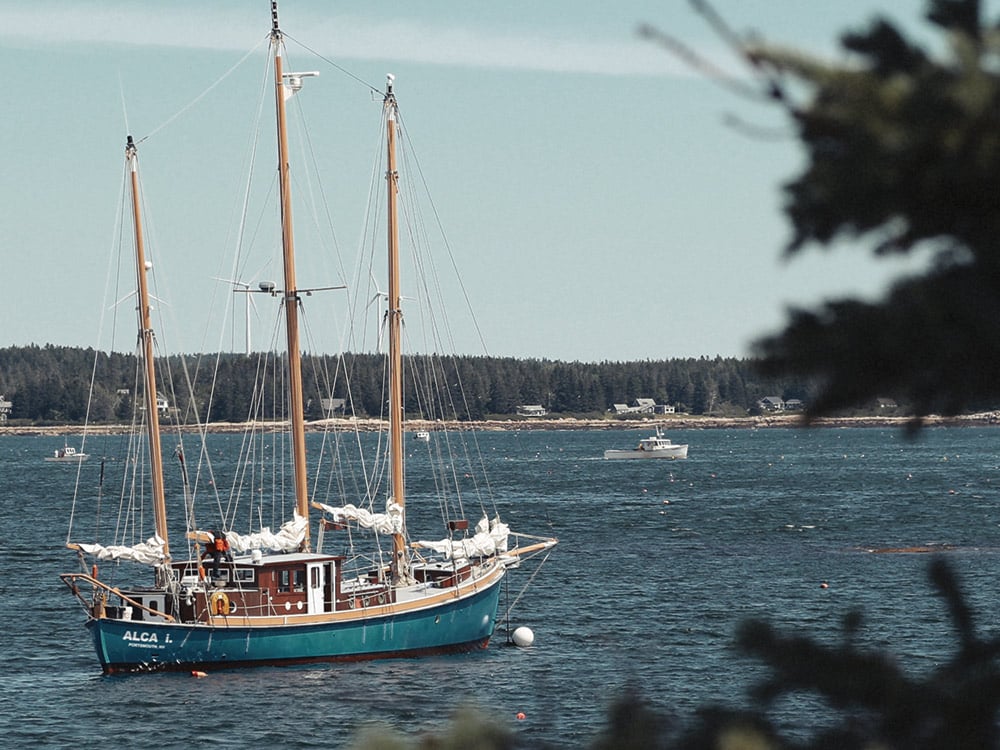
It’s about 9 o’clock on a beautiful Maine summer evening, a plum sunset fading to cobalt blue over the pointed firs. And while the rest of the cruising community does what it does at about this time — packs off to bed at “cruiser’s midnight” or catches some twilit stargazing — the wet lab that occupies the aft compartment of the schooner Alca i is quietly bustling. Thew Suskiewicz, a 36-year-old marine ecologist who specializes in macro-algae and kelps in particular, gently lifts a piece of what the typical sailor would call “seaweed” from a plastic tray. “We’ll start with Porphyra. That’s going to be trace. … Ceramium, also going to be trace. Polysiphonia, big one, 39. … Oh, look, Ptilota. We do have a Ptilota!” he says, holding a maroon leafy thing on his fingertip. “That’s a distinctive subarctic species that used to be much more abundant.” Beside him, Danielle Frechette, 35, a marine biologist who is researching salmon in Quebec, Canada, for her Ph.D. and is here to attain necessary credits outside her area of study, records every name and number on a sheet of paper taped to the cupboard over the work table — genus, sometimes species, weight, length.
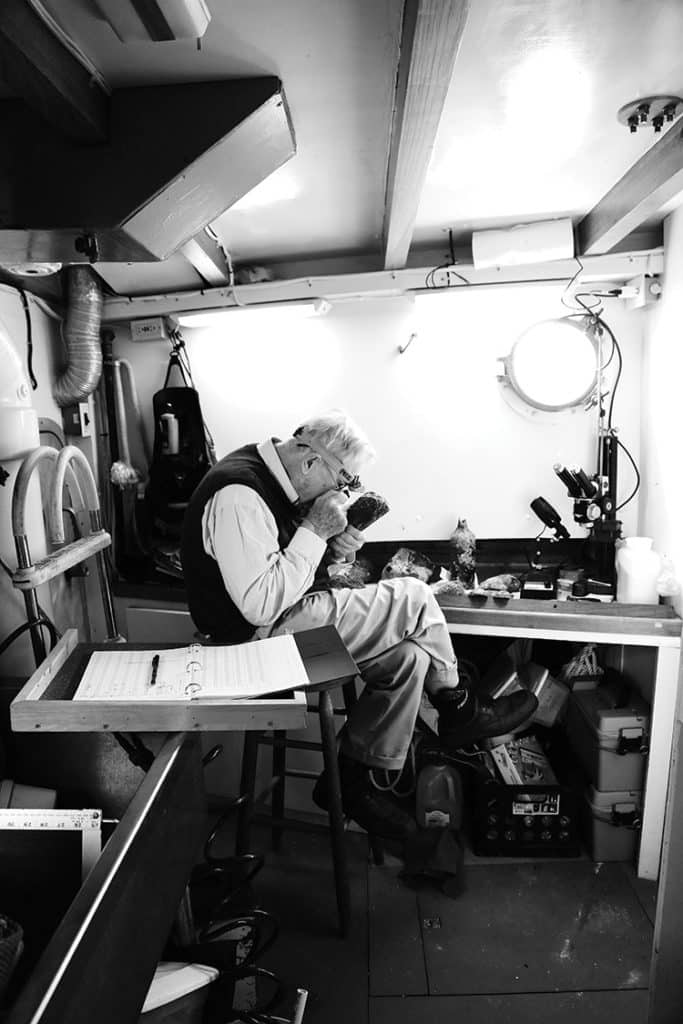
A few feet away, Alex Brett, 28, a diver and ship’s engineer for this expedition with a 200-ton U.S. Coast Guard master’s license, a 1,600-ton mate’s and a background in marine science as an undergrad at the College of the Atlantic, joins Lauren Rice, 22, fresh from earning her bachelor’s degree in marine science from the University of Maine, leaning over an industrial stainless-steel sink. Playing a kind of algal Where’s Waldo over two plastic trays, the two carefully sort the contents of a mesh bag that Lauren and Thew filled several hours ago while diving at a site just south of Hurricane Island at the mouth of Penobscot Bay. As they tweeze the mass of weed apart, identifying dozens of individuals as diverse as long, flat kelps and tiny, filigreed feathers like Ptilota, they segregate each type so Thew can weigh, measure and record.
It will be another hour or so before the data collecting is completed from today’s dives. Three steps up and forward, the pilothouse glows warmly in the lowered lights. The galley is quiet, all put away after a dinner of chicken curry. The ship’s master, Walter Adey, a research scientist emeritus at the Smithsonian National Museum of Natural History, and his wife, Emmy Award-winning Smithsonian filmmaker Karen Loveland Adey, have already turned in. For the days are long on the Alca i. She has a lot of work to do, and the dawn comes early this time of year this far east.
It’s safe to say that this home-built 64-foot schooner is unique, not only in who she is but in what she does. Conceived to provide the ideal research platform to study shallow-water algae — especially subarctic species in waters as far north as 60-plus degrees latitude — she’s strip-planked of red and white oak that Walter and his son Erik cut on their farm on Virginia’s Ware River. Since her launch in 2003, she has sailed about 18,000 nautical miles between the Chesapeake Bay and the uppermost reaches of Newfoundland and Labrador, Canada, through 10 expedition seasons. She’s named for Alca impennis, the great auk, a cold-water penguinlike, flightless diving bird that became extinct in the mid-1800s.
“One of my original intentions when this whole thing started was to do the Northwest Passage,” says Walter, whose lifelong career studying algae is still going strong despite his retirement from Smithsonian a year ago. “The boat itself was built to be like Fram [a circa 1900 high-latitude wooden research ship], meant to be locked in ice. It can definitely take it, but I’m not sure Karen and I can do that kind of trip at this point.” Indeed, this may be Walter’s last expedition aboard the Alca i, which is for sale, a topic nobody much wants to talk about.
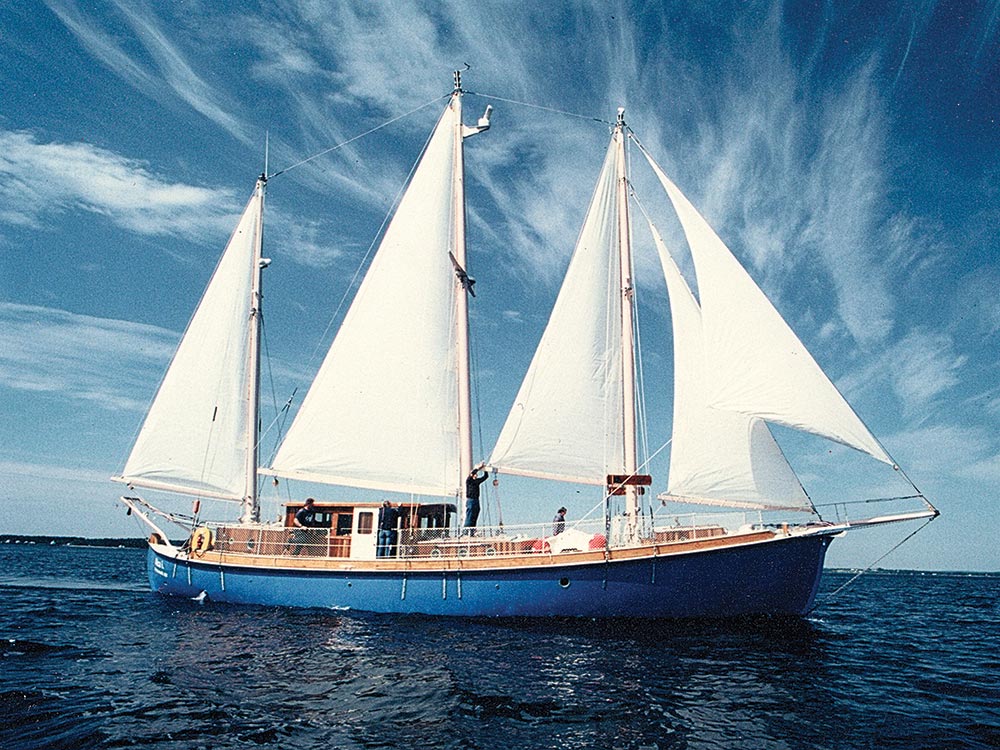
She is not his first purpose-built boat. From the start, Walter has taken the unexpected path, and boats have always figured into those journeys, although the pursuit of the science has always been the driver, not the sailing per se.
“I’m afraid for better or worse I live for science, and boats do the job for me,” Walter says. “And I like to be aboard, I rarely go ashore. This is great. What more could you want?” The child of Newfoundlanders, one of Walter’s earliest memories is of his mother’s grief at burying her brother, who died at sea. The family moved to the Boston area, where his father gave up the sea for a career as a carpenter. “So I grew up with a shop and full access to it. I built some boats — kayaks, skiffs — but that was all. Nobody went to sea anymore in my family. That was it.” That wasn’t it, though, for Walter.
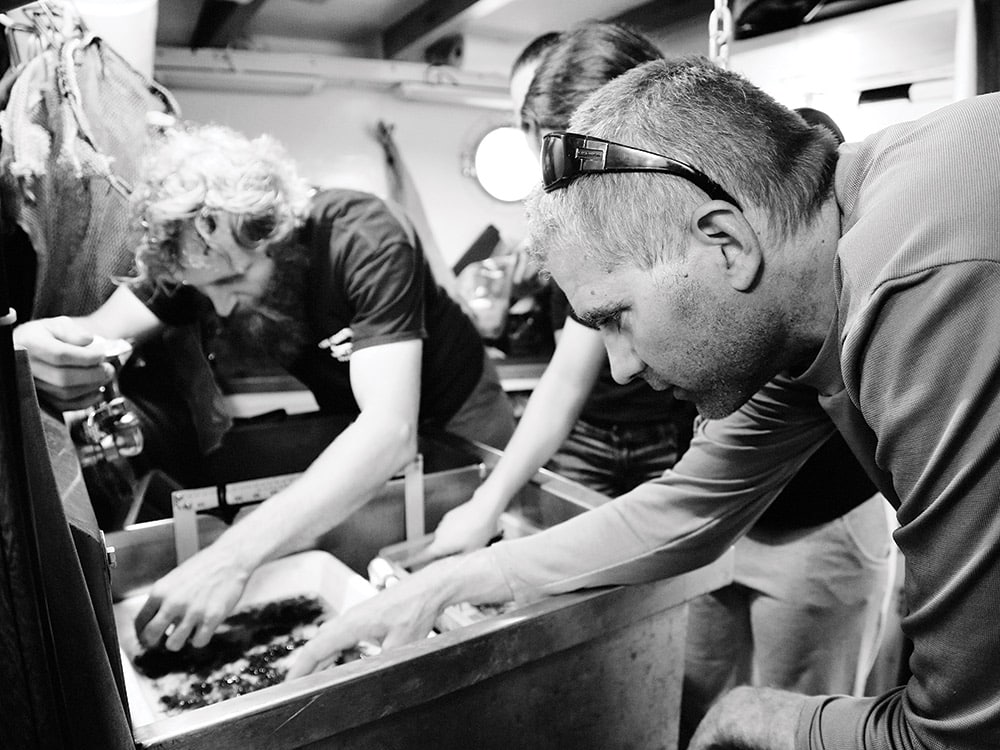
“I was at MIT for geophysics,” he says, “and I was scheming to be a marine biologist and go to sea.” He did it after turning down a rare fellowship position aboard Atlantis, a 142-foot steel ketch built by Woods Hole Oceanographic Institution as the first interdisciplinary research ship in marine biology, oceanography and marine geology. Anyone else would have killed for a berth on the world’s premier research vessel to conduct doctorate studies in chemical oceanography. But Walter wanted to do something new — an ecosystem analysis of an entire coastal marine bay. So he said no thanks, and started looking for a boat of his own.
“I’m afraid for better or worse I live for science, and boats do the job for me. I like to be aboard; I rarely go ashore.”
He found an unlikely candidate in Gloucester, Virginia, a 34-foot cedar purse-seine boat from the Reedville menhaden fleet.
“They were going for next to nothing, which is all I had, so I acquired one,” he says. “And being half carpenter, I put a deck and a house on it. It had this tiny little Lathrop four-cylinder engine in a box, and that was it.” It also had a lab, a tiny compressor to fill dive tanks and a charcoal stove for cooking. Sleeping accommodations were a bag on deck, and water came from any freshwater source he could find. It was 1959. He didn’t know much about navigating, knew even less about basic skills such as anchoring, but figured he’d learn on the way to Maine.
“We made it to Dyer Bay after a few learning lessons of a sinking and a crankshaft breaking in half. But anyways, we made it.” (A born raconteur, Walter’s stories are peppered with “but anyways” moments.)
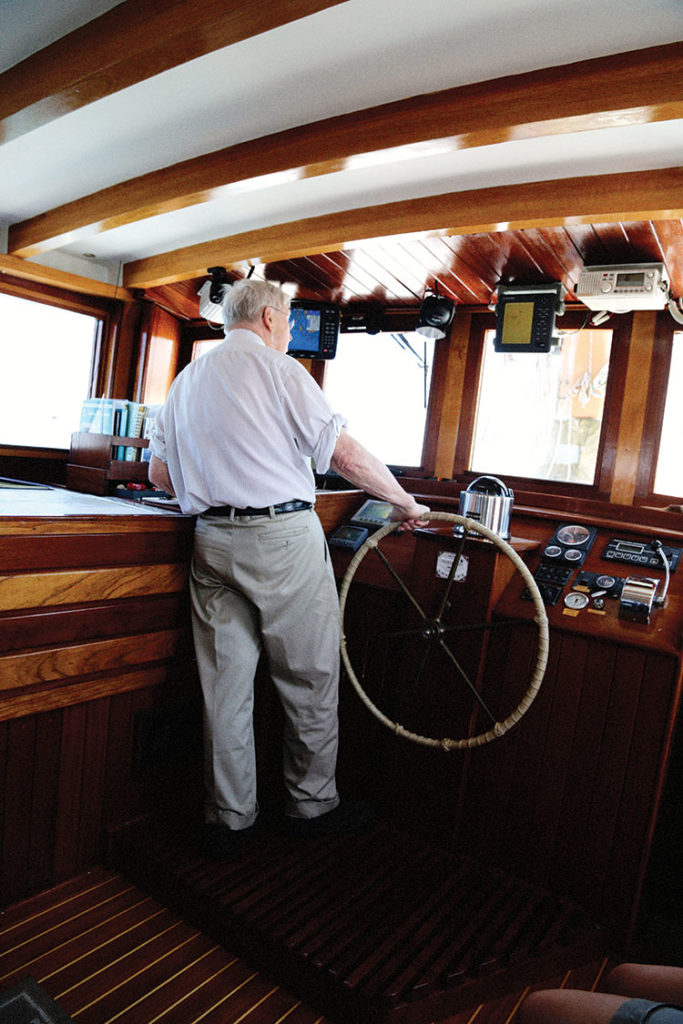
That MO — let’s try it and see what happens — would carry Walter through a groundbreaking career in the study of corallines, hard, pink algae that can live thousands of years, archiving information in their cells and structures, and which scientists only now are really beginning to mine for baseline climate data going back generations.
His study of corallines would require more boats, and because most scientists are always scrambling for funding, Walter’s boats ran the gamut. They included a 45-foot motor vessel built in Deer Isle, Maine, on which he covered the coast of Nova Scotia, the Gulf of St. Lawrence and the coast of Newfoundland all the way to Cape Chidley, an island off the northeastern tip of the Labrador Peninsula at 60° 22’ N. “Of course, it didn’t have GPS or anything like that,” he says. The RDF was useless, since there were no stations to home in on, although “it did have the newfangled VHF radio.”
For a time, he used a 17-foot Boston Whaler to conduct research in Iceland, launching over the cobbled shore and camping between dives. This didn’t work too well because the wind kept blowing the tents down. After that came a 75-foot Norwegian salvage boat that had been used for fishing. And then, in the 1970s, Corallina, a 41-foot Piver-designed trimaran he built in his backyard in three sections (so it would fit through the carport) and took to the Caribbean for years of research. “It was a great boat. The lab was right in the middle. The galley was aft. To get into it you had to duck under the crossbeam,” he says. “The big space was the lab, of course. How could it be anything else?”
In 2001, using his coralline research as its basis, Walter copublished a major paper on biogeography, “a beautiful model of why shallow benthic organisms, photic organisms down to the limit of light, would be distributed over the world. … The only qualitative, quantitative research on biogeography that I knew of at the time.” The problem, though, was a kind of corallines stigma — “They’re blobs on a rock! That kind of thing,” he says. (Also, as Thew points out, Walter is one of the few people in the world who can accurately identify them, which limits their popularity as a research topic.) To further prove the model, as well as to examine how the geographic distribution of algae was shifting — and explore possible reasons why — he decided “we have to do all the other algae. We can’t just do corallines.”
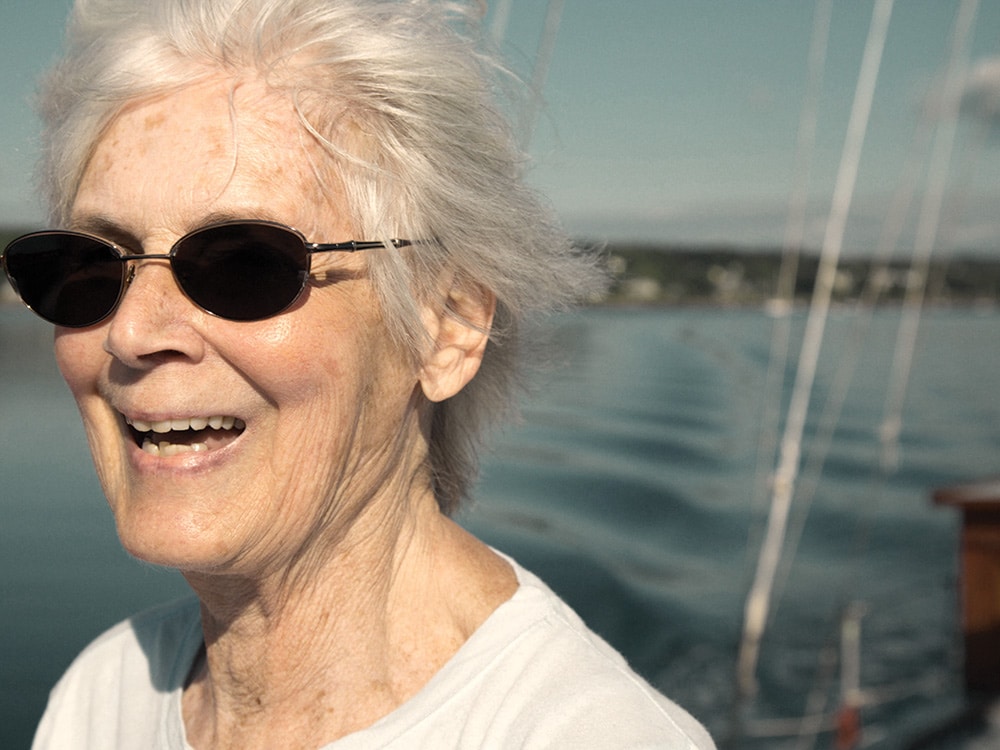
So the idea of the Alca i was born. Knowing he required a safe, strong boat that could provide a comfortable platform for research in shallow, largely uncharted, cold waters where he had established baseline data decades earlier and would need to revisit, he turned to a Colin Archer-inspired design. He hired George Buehler, a Pacific Northwest architect, to provide the lines, and in typical Walter fashion, read a book on lofting to shape the hull. He was 65 years old. He admits, “This was crazy. Nobody in their right mind at 65 would say, ‘I’m going to build this boat and go to sea.'”
His son Erik, a biologist by profession with a passion for traditional sailboats and the mind and skillfulness of a born mechanic, helped from the outset, designing and installing all of the systems for comfort of living and efficiency of research. They cut all the lumber from their Virginia property, drying it in a huge greenhouse that had been used for an aquaculture project. Rather than forced drying, the slow, diurnal rhythms of heating and cooling allowed the wood to dry slowly to achieve the ideal moisture content when the time came to work it.
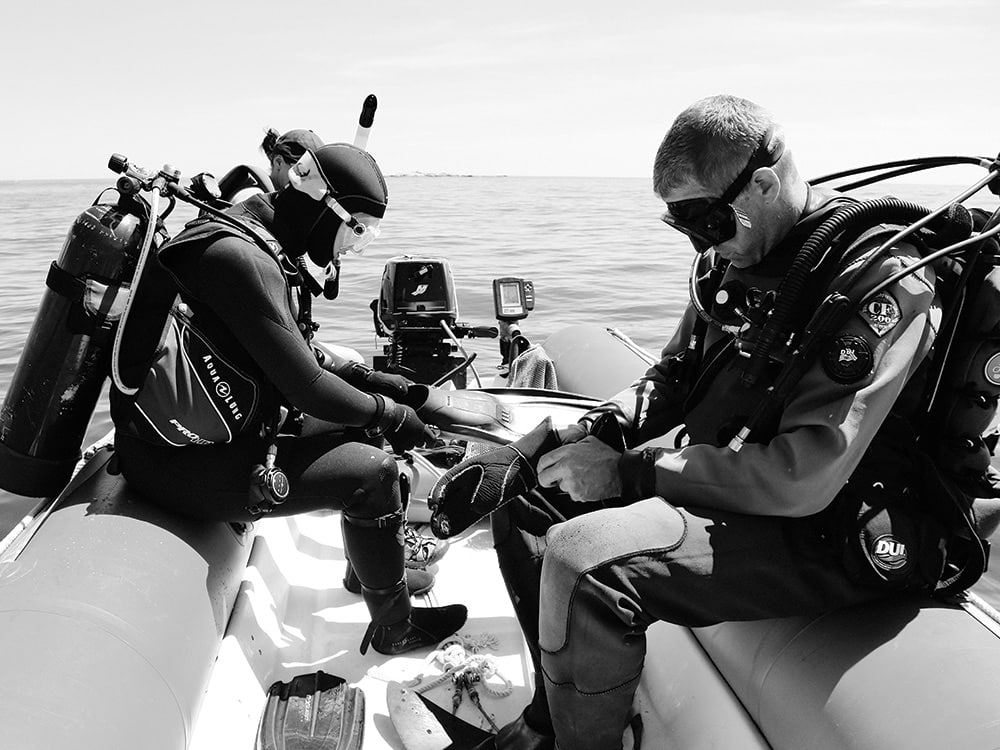
It took three years and a small army, marshaled and managed by Karen, the organizer who secured needed loans, found skilled helpers and kept all the wheels on the bus while still making films and traveling with Walter doing coastal sampling in the summers — because the science doesn’t stop just because you’re building a boat.
Well-known Chesapeake builder Clinton Midgett, of Mobjack Bay, finished the pilothouse, the galley and the three spruce hollow spars. Seven watertight bulkheads include two collision bulkheads forward. Alca i draws 6 feet and displaces about 50 tons, with a sail area of 1,328 square feet. Powered with a 180 hp Cummins diesel (the toasty engine room is a favorite hangout for chilly divers), she has a range of about 2,000 miles on 1,300 gallons of diesel distributed in 10 welded aluminum tanks, which can be trimmed as needed using a fuel transfer system.
Other people measure a boat’s success in trophies or cruising miles. Walter gauges Alca i’s in publishable research.
“I insisted on standing headroom on both sides of the engine, with two workbenches on either side,” Walter says. “If you’re going to work in Labrador, you’ve got to be able to repair whatever goes wrong. Every piece of equipment has to be doubled in one way or another. You have to have backups.”
Two generators — 5 kW and 17 kW — supply electrical needs; the latter can serve as backup to the engine to drive the hydraulic systems that power electric winches, the bow thruster and bilge pumps, among other things. Although dedicated to lab space, with workbenches, sinks and storage for the dive compressor and tanks, the aft cabin was designed to be converted to a large master cabin if the boat’s purpose changed later.
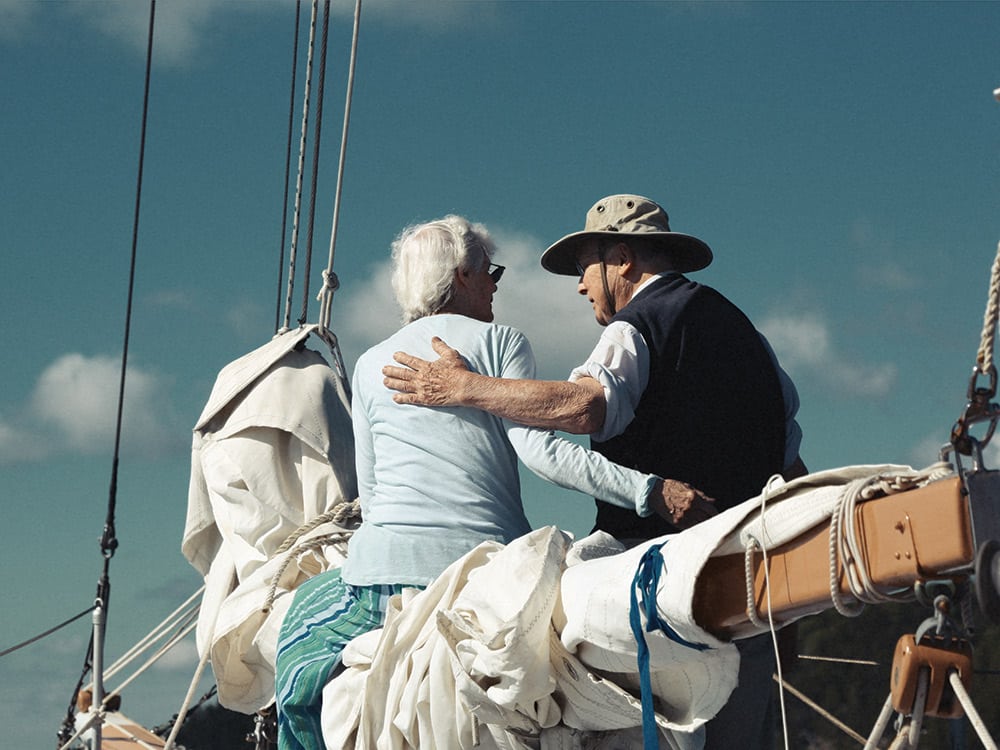
After Alca i‘s launch in July 2003, Walter and team immediately sailed for Shelburne, Nova Scotia, and then Newfoundland. Since then, they have made nine expeditions, and this year is the 10th, with seven weeks of research in 15-day chunks from Penobscot Bay to Machias Bay, taking new data from sites Walter first sampled decades ago. Everyone on the boat this season is volunteering their time, and Walter is donating the boat to the cause at no cost.
Other people measure a boat’s success in trophies or cruising miles, or maybe personal happiness. Walter gauges Alca i‘s in publishable research that can advance the science revealing the effects of climate change in measurable, quantifiable ways.
“Interestingly enough, this is my eighth research vessel over 55 however many years,” he says. “And this has produced more papers than any other boat, even Smithsonian boats and boats that came with huge funding. It’s approaching 20 now, I guess, because it’s such an important topic.”
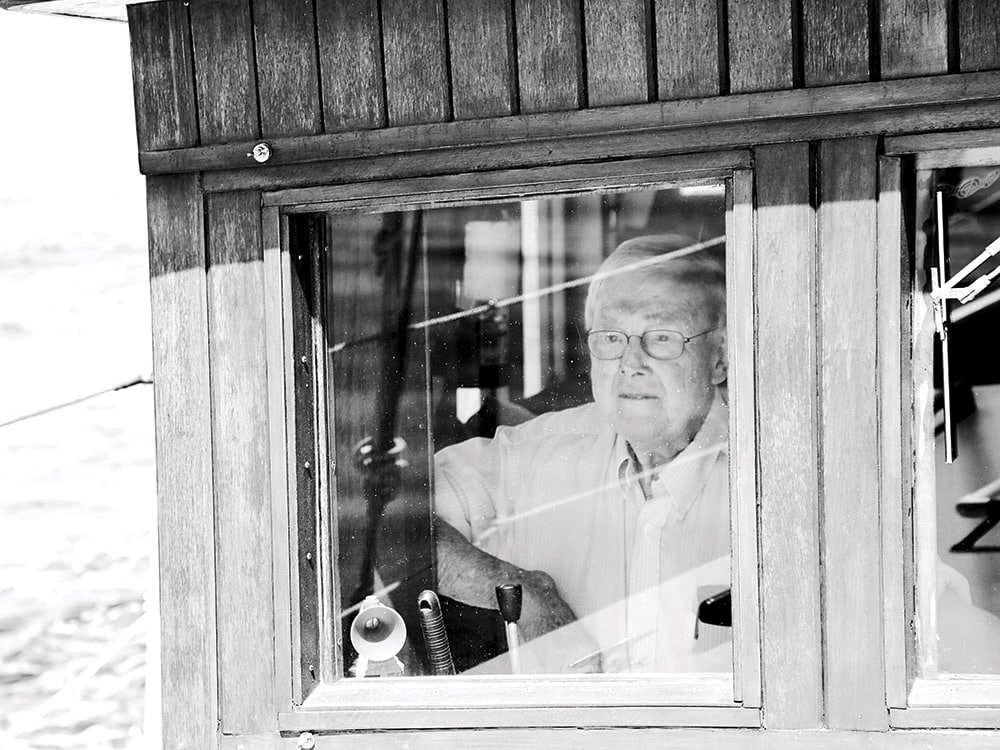
Thew, whose first expedition on Alca i was in 2010, is supporting Walter’s coralline collecting while also studying the changing population and distribution of “fleshy” algae — which may be happening due to warmer seas, shifting predators, sedimentation or possibly, as he says, “D, all of the above.”
“The whole ecosystem is changing, and it looks much different than it looked just 10 years ago,” he says of this part of Maine’s coast. “That’s really fascinating, and really scary.” He and Lauren will dive and sample at each station three times, at 5, 10 and 15 meters.
“I give Walter so much credit for his foresight in building this boat,” Thew says. “Last year, we hit nine sites in four weeks from land. The Alca i lets us do 40 sites in seven weeks. You can get 10 times the science — and much better science — and it takes care of your food, transportation and science needs.”
And, she’s powerful and lovely, something for which Karen is ever grateful. Although building the boat “was a huge undertaking financially, physically, emotionally,” she says, it enables Walter to pursue answers to his limitless questions, and for her to be in the place she needs above all others, on big water. “It’s not the same thing for me,” she says. “I’m very supportive of his science, but it allows me to enjoy sailing and being at sea, where I want to be more than anything else.”
Whether Alca i will be sailing next summer, no one knows for sure. But if science is any kind of metaphor for life, then it’s helpful to consider the journey that has brought Walter, Karen, Thew and the rest of the team here, to this evening of long twilight at the edge of the ocean, with a full day of research and possibilities ahead.”Science projects often turn out to be different than what was planned and expected, and usually that’s a good thing,” Walter says. “That’s been my experience, at least.”








